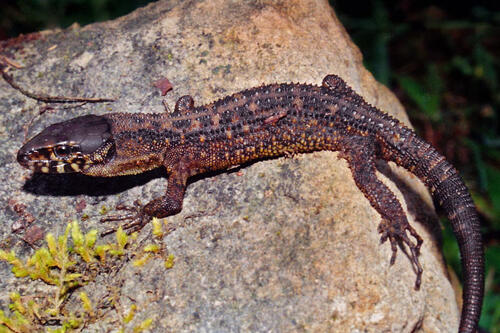
An asteroid strike 66 million years ago caused a mass extinction that wiped out 75% of Earth’s animal species, including all non-avian dinosaurs. But “night” lizards survived.
A new Yale study has found that the oldest common ancestor of today’s xantusiid night lizards — small lizards that, despite their name, are most active during the day — predates the Cretaceous–Paleogene (K-Pg) extinction event. And they endured despite living in ecosystems within and near the Yucatan Peninsula, the site of the asteroid impact.
The study challenges prevailing hypotheses concerning the life history traits associated with surviving mass extinctions, the researchers said.
“We show that xantusiid night lizards are the only living family of terrestrial vertebrates known to survive of the K–Pg mass extinction in proximity to where the asteroid struck,” said Chase Brownstein, a student in Yale’s Graduate School of Arts and Sciences, in the Department of Ecology & Evolutionary Biology, and the study’s lead author. “This is especially interesting because night lizards don’t fit neatly into the conventional understanding of how to survive a mass extinction. For example, they have small litter sizes of one or two individuals when it’s widely believed that having a lot of offspring enhances the chances of survival.”
The study, published in the journal Biology Letters, originated in a seminar co-taught by Yale professors and YIBS Faculty Affiliates, Thomas Near and Martha Muñoz, that focused on large-scale evolutionary changes to squamates, the order of reptiles that includes lizards and snakes.
“This paper demonstrates that when faculty members collaborate on teaching a class, exciting research can result,” said Near, professor of Ecology and Evolutionary Biology in Yale’s Faculty of Arts and Sciences (FAS), and a co-author of the study. “In this case, it gave students like Chase an opportunity to pursue interesting research and also brought together two labs that don’t always have the chance to work together.”
Muñoz, associate professor of Ecology and Evolutionary Biology, also co-authored the study.
Xantusiid night lizards are a species-poor lineage (an evolutionary lineage with relatively few living species) with conserved anatomy, meaning their anatomical features have remained relatively unchanged over evolutionary time across species. Despite their name, night lizards are most active during the day and at twilight. They live in microhabitats — small-scale environments, such as rock crevices or decaying logs, with unique properties from the surrounding ecosystem.
For their analysis, the researchers created a time-calibrated evolutionary tree using a technique called Bayesian tip-dating, which combines molecular genetic data with fossil specimens. They used DNA data for seven nuclear genes stored in GenBank, a database of all publicly available DNA sequences maintained by the U.S. National Institutes of Health.
The researchers placed fossils at the tips of the tree’s branches, which helped to calibrate time. They restricted the analysis to nuclear genetic data (which is extracted from the nucleus of cells) as opposed to mitochondrial data (genetic information contained in the “powerhouse” of the cells), which prior research has shown artificially inflates estimates of when species diverged, the researchers noted.
Night lizards have been endemic to North and Central America since the early stages of the Late Cretaceous, about 92 million years ago, according to the analysis. The results support the hypothesis that at least two lineages of night lizards persisted through the K–Pg extinction event, the researchers said.
By integrating life history data from living night lizard species, the researchers showed that the night lizard ancestors that witnessed the asteroid impact likely produced litter or clutch sizes of one or two babies.
For more information, click here for an article published by Yale News or here for the full study in Biology Letters.



